Another week gone by already and another month, for here we are in September. Now remember as we get towards the closing of the year we will need to entertain those long hours when it is dark from the middle of the afternoon - so if anyone out there is doing something exciting, or has a collection they would like to chat about, please contact us at webmaster@card-world.co.uk .
We also need to have as much notice as possible about your Cartophilic Christmas Events, especially dates, times, and whether they are member only, or open to all.
So what can we look forward to getting involved with this week? Well lets start with ...
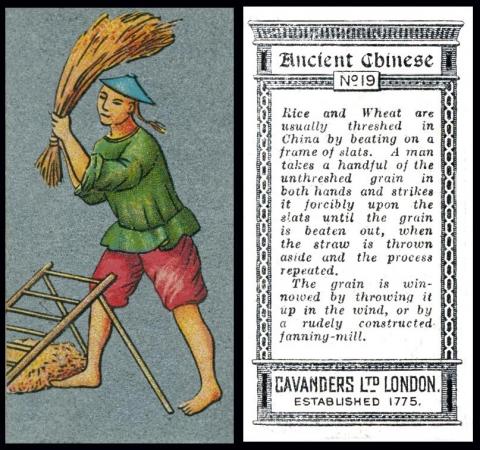
Today is World Beard Day, but I will pass over my delight in such things and start with a bit of a poser, for this card almost certainly shows a beard but it is not on the thresher man.
To put you out of your misery, wheat, barley, rice, and some other grains, for rice is also a grain, have what are known as beards, these being one or more spikes that bristle out around the seed to protect it.
Some grasses have them too, and they are what stick in the fur of your dog, or sometimes their foot and cause all manner of trouble including a trip to the vets. By the way, the technical name for the each section of this "beard" is an awn, if you want to impress your fellow dog walkers.
Wheat did not grow in China, it was introduced, and the first people to grow it lived in what we now call Turkey. However the Chinese were definitely the first to grow rice. Today half the world population have rice as part of their main meals, whether cooked, or ground into flour. And this card shows how they used to get that grain before mechanisation; physical human power, for prolonged hours on end.
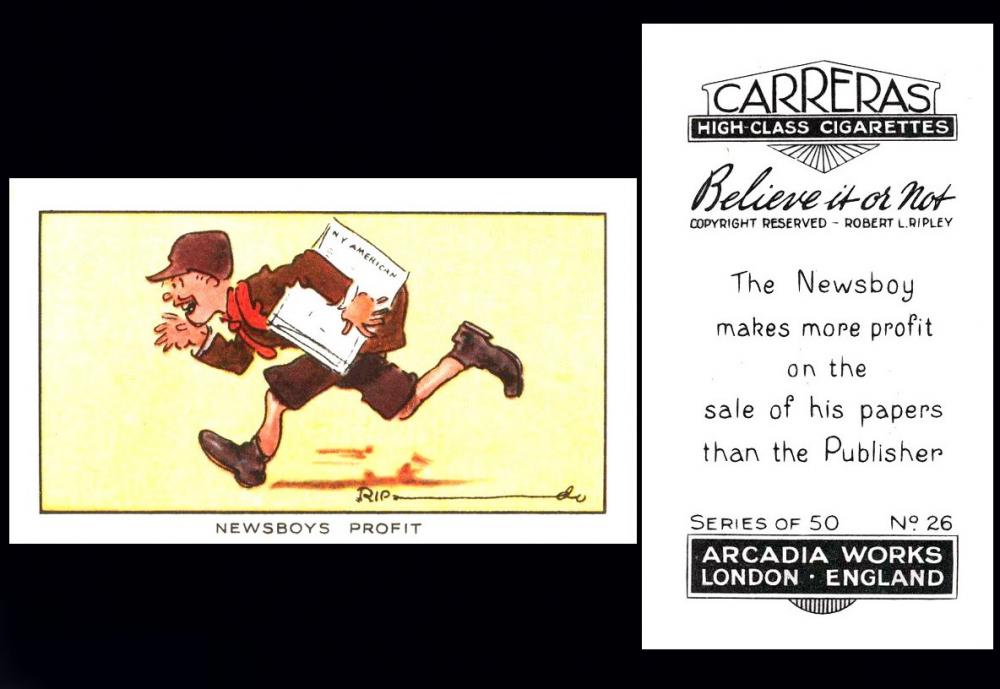
Today is Newspaper Carrier Day, celebrating the unsung hero who makes sure you can read the news over your breakfast.
Of course these days some of us would rather not read such gloomy and distressing fare first thing in the morning, and those of us who want to now have almost certainly been checking their favourite app in bed since their eyes first opened.
I don`t know anyone who has their newspaper delivered any more, but then most of my friends are like me, and read the important things only, the sport, art, films, books, gardening, and music, then as soon as they hit a bit of proper news we put the paper out for the recycling.
The newspaper carrier, even today, is often young, and the money they are paid is not much, but it supposedly supplements their pocket money and lays the foundations for a proper job. Or so I have been told. I have also been told they get only pennies per paper, so I am not sure I believe the statement on this card, for why would the publisher bother to keep going if they get less than pennies on each one? It would surely make more sense for them to deliver the papers and get someone else to publish it ! But I welcome being corrected.
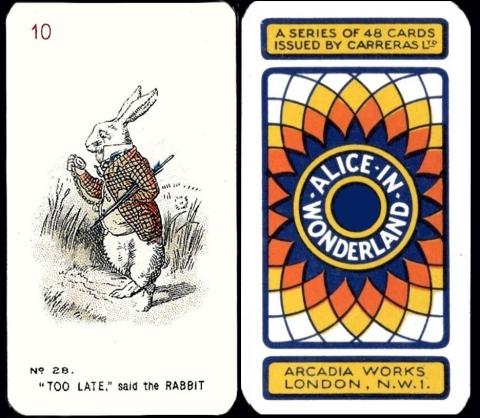
Today, why not "Be Late For Something"? For that is what is being celebrated today.
The first connection which entered my mind was Alice and the White Rabbit, with their pocket watch, and here they are, courtesy of Carreras, who used the very illustrations drawn for the book in 1895 by John Tenniel.
And even the title fits!
The White Rabbit is one of the characters that most people remember, even if they have not read the book. Lewis Carroll liked him too, and he appears right at the start of Alice's Adventures in Wonderland, with his tweedy waistcoat. His actual words are "Oh dear! Oh dear! I shall be too late!" And then Alice follows him down into his rabbit hole and finds herself in Wonderland.
In case you don`t know, whilst he often says he is late for a very important date, it is not a romantic date with another rabbit, but a date with the Queen of Hearts, who needs him to fulfil the terms of his employment as her herald, and announce that she has arrived where she is going.
In our original World Tobacco Issues Index this set falls under section 2A of the Carreras issues, these being "Games and Playing Card issues". The header tells us that "leaflets or guides usually issued explaining rules" and that the cards were "all with rounded corners unless stated". In fact there was only one set with square corners and it is exactly the same in all other respects as our set today. You can see that as the card of the day for January 15. 2024.
The set is catalogued as :
ALICE IN WONDERLAND. Nd. (48)
A. Small, with (a) rounded (b) square corners
B. Large
Whilst this description remains in the updated World Tobacco Issues Index, the header is altered and gives us the size "Small size 67-68 x 35-37, Medium 67-70 x 60, Large 76-78 x 61-62" as well as expanding the details of the leaflets to read "Paper instructions leaflets explaining rules issued, unless otherwise indicated".
There was a leaflet for this set
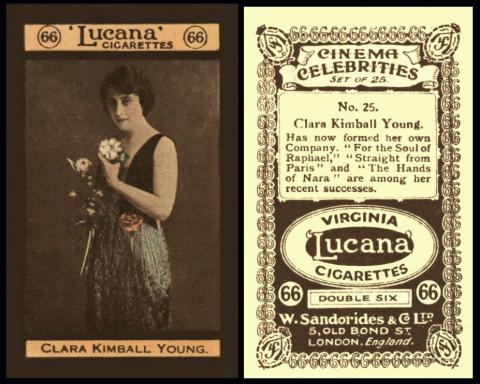
Today we celebrate the charms of Clarissa Kimball, born on this day in 1890.
Few if you may remember her, or even have heard of her, but in her day she was very famous and influential, in fact at one point in her career she was earning $1,000 a week
She was best known for upmarket "Society Dramas", and married fellow actor James Young in about 1909. He was eighteen years older, and she was his second wife. Then in 1914 she had met producer Lewis J Selznick, with whom she had signed a contract, and taken a shine to. She remained married to James Young, but her films slowly took on a more lurid tone and she appeared nude in "Trilby" in 1915, a film in which her husband, also appeared. The following year Selznick set her up with a film company of her own, The Clara Kimball Young Film Company., of which she was Vice President and Treasurer. At that time, she was only the second female star with her own company - the other being The World`s Sweetheart, Mary Pickford. This was the final straw and her husband sued Selznick, saying he had turned his wife against him; she went so far as to countersue, and the pair were divorced in 1919, though she continued to use his surname after, and even whilst he had two more wives.
By this time she had also fallen out with Selznick, and all three of the films listed on the back of our card, released respectively in 1920 1921 and 1922, were directed by a theatrical impresario called Harry Garson, with whom she had become romantically involved. It was a stormy affair, and James Young, who was obviously still enamoured with her, once attacked him with a penknife.
The rest of her career was blighted by continual lawsuits with Selznick. She remained with Harry Garson until 1928, then they divorced and she married again. When he died in 1937 she never remarried. She continued to work in film and on television but sadly she is almost forgotten today. She died in 1960.
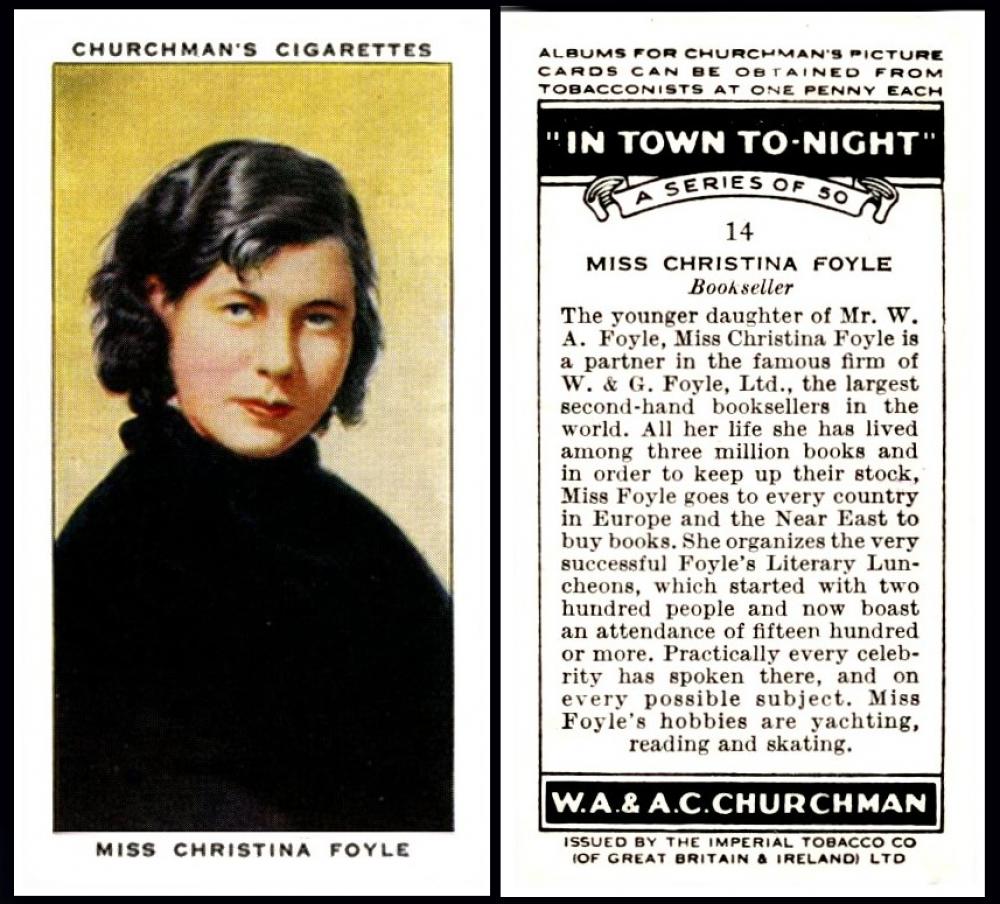
A pair of events yesterday and today that I always think the wrong way round, for yesterday was "Read a Book Day", and today "Buy a Book Day". Though I guess that if you read something that caught your heart you might well buy it as soon as you were able.
If you bought a book in London at one time, there was a high chance that it would have come from Foyles, and they are still going strong, with regional branches. Generations of readers have sheltered there from the rain and tried to surreptitiously research without having to buy the books.
It all started in 1903 with brothers William and Gilbert Foyle not getting the results they required in order to join the Civil Service, and deciding not to try again, but just to sell the books they had amassed to some of the other people who were just starting to study. This would clear them out, and perhaps make a few pennies. Just like many of us, who sell our first unwanted household item online, enjoy doing it, and look around for more to sell, Foyles became a bookseller, with premises in London.
Our card shows Christina Agnes Lilian Foyle, born in January 1911 and dying quite recently, in June 1999. She was one of their three children, and had actually been a debt collector at one time.
In 2018, Foyles was sold to Waterstones, who had moved into the shop next door a few years prior. The sale was with one condition, that the family name must endure.
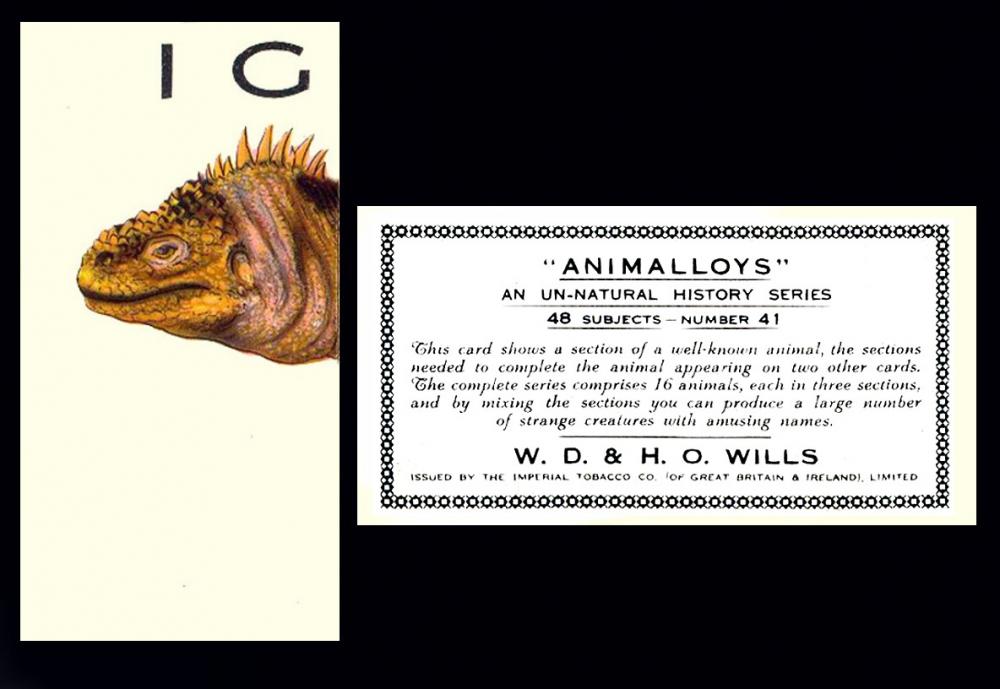
Today it is National Iguana Awareness Day, so here is a curious sectional card showing just the head of a particularly interesting specimen. You can see the entire iguana trio online at the New York Public Library
The iguanas is a reptile, cold blooded and not exactly designed to be a pet, for despite their interesting appearance they have a temper and they bite, as well as wielding a long tail which can be used as a weapon against anyone who annoys them, They also grow to a length of six feet.
In the wild, that being South America, and parts of Central America. It is believed that the first ones in North America were either smuggled in, or somehow managed to find their way on board a boat heading in that direction. They are now part of the wildlife in the warmer states.
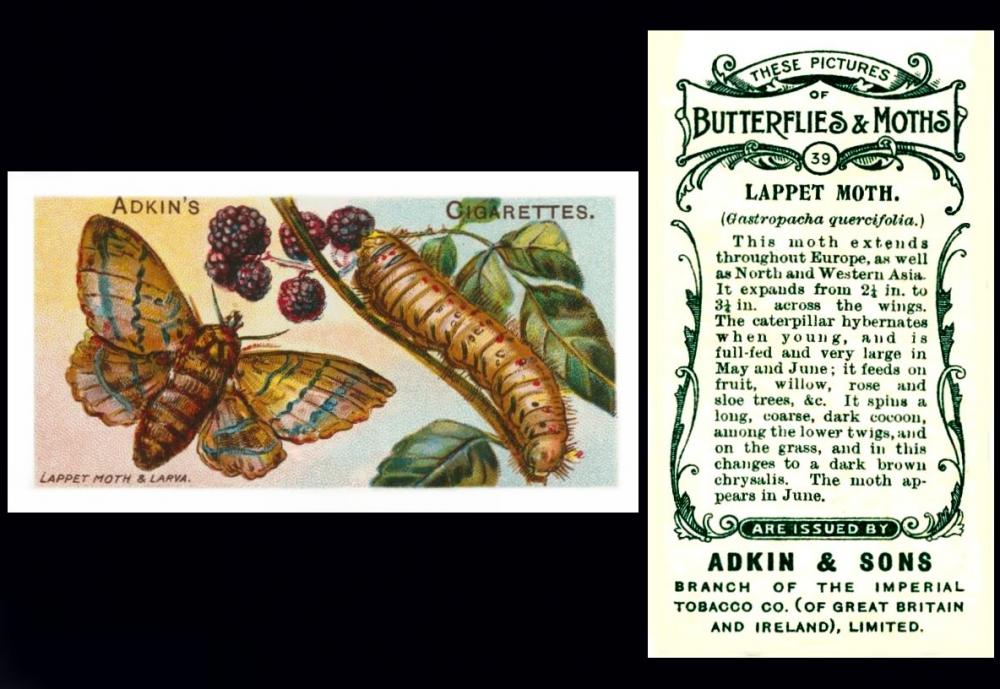
Adkin & Sons [tobacco : UK] "Butterflies & Moths" (1924 or 1933) 39/50 - A/5 [RB.5/5]
A curious tale now, with a sad ending, and I might be using a picture of an entirely different moth, but if so perhaps a lepidopterist will get in touch.
On September 9, 1947, the world`s first computer bug was discovered. The computer in question was at Harvard University, and things had not been going well with it for some time, so an investigation was made and the casing opened. That was when they found a bug had attacked the machine.
The bug was removed, by hand, and stuck in a notebook, for it was not an unwonted programme, but a moth. The workers had seen it flying about for some time, and swatted it, but it had disappeared and they thought it had found a way out, but instead it had obviously gained access through the casing of one of the machines.
The bug exists to this day, sellotaped in place. You can see it online, courtesy of the National Geographic - and do note that above it is written “First actual case of bug being found".
This set has two dates, simply because the series was issued twice, and there is no way to tell which card comes from which date as it was a straight reprint. It is first listed in our original reference book to the issues of Messrs. Abdulla, Adkin, and Anstie (RB.5, published in 1943) as :
1924. 50 BUTTERFLIES AND MOTHS (titled series). Size 2 5/8" x 1 7/16". Numbered 1-50. A series showing larva, foliage on which it feeds, and moth or butterfly with spread wings. Fronts, lithographed in full colours, with white margins. Inscribed "Adkin`s Cigarettes" at top, subject title at bottom. Backs, printed in grey. "These pictures - of - Butterflies and Moths - number - title in English and Latin - description - are issued by - Adkin & Sons - Branch of the Imperial Tobacco Co. (of Great Britain and Ireland) Limited. This series was reissued about 1933.
However it fails to mention that this set was also issued by Wm. Clarke and by John Player. Maybe that was not yet known? In any event we have used the Clarke version as the Card of the Day for the 6th of September 2024, and you can read more there.
This week's Cards of the Day...
.... looked forward to the Blackpool Illuminations, which lit up the night sky for this season on Friday, the 2nd of September. This year they are not just having the usual six week run to take them just in to November, they will continue right through until January 2023, but do note that they will slowly start earlier as the light fades quicker in the day, until in December they will begin at 4.30 pm. Full details appear on the official Illuminations website
Saturday, 27th August 2022

Here we have Alan Ball, who started at Blackpool in September 1961 as an apprentice, having been turned down by Bolton and Wolverhampton Wanderers, both of whom said he was too small, though curiously he had been connected with, and played for Wolverhampton Wanderers junior team whilst at school. Bolton Wanderers was his second choice. He then managed to get a slot at Blackpool, through a friend of his father`s.
He is chiefly remembered now for being in the 1966 World Cup, and perhaps for being the youngest member of the squad, aged just 21. After that , he left Blackpool in 1966 and was signed by Everton, in whose strip he appears here.
After his playing career was over he went into coaching, and managed several teams. He died, of a heart attack, in 2007.
The curious coincidence with this card was that I planned to give you Ginger Cat Appreciation Week, and as Alan Ball had ginger hair, he was card one in the theme. However after I had put him in the media gallery and started looking for ginger cat cards I realised one card of a ginger cat was only possible if I counted an obscure reference to one on the reverse of a card. So I hunted, quickly, for another theme. Blackpool seemed to be a bit more reasonable to source cards from, but imagine my surprise when Alan Ball turned out to be connected with Blackpool too....
Our original British Trade Index part II tells us that this set is from the "Footballers Grouping" which appears in full with the Card of the Day for October 19 2024, simply because that was the first football set ever to be issued by A & B.C. Gum, in 1958-1959. All the other sets are tackled like today`s, in as much as they simply repeat their section of the listing, and not how it interacts with the other sets.
So today`s card is listed as :
FOOTBALLERS GROUPING (A). Md. or Lg. 8 backs illustrated at Fig. ABF-10. Nd. ... ABF-10
9. Portrait in rectangle with rounded corners, white border team name in pennant at base. Back in yellow. 81 x 55. (101)
1. Nos. 1/54. No. 1 is unnumbered team picture of West Bromwich Albion, back "Football Check List". Anonymous team pennants, see set ZJ12-8.1, were issued with this section.
2. Nos.55/101. No. 55 is unnumbered team picture of Manchester City, back "Football Check List". Anonymous Metalised Team Emblems, see Set ZJ12-8.2 were issued with this section
Before we race ahead, there is a curious anomaly with the base set, and that is that you can find the cards with or without a football logo in the banner which holds the player`s name, and in just one instance, shown at the Trading Card Database/Joe Baker you can find that one card with and without the logo. Unless anyone out there knows of another card which has both? You can also find a checklist of the set at the Trading Card Database/1968 - as well as a really curious item, the original negatives.
Now as far as the first part of this set, numbered 1/54, that appears as our Card of the Day for the 2nd of September, 2023 - however, as the anonymous extras are specific to one part of the set only they are tackled in detail on each page, so here we only have the metalised team emblems. That entry reads :
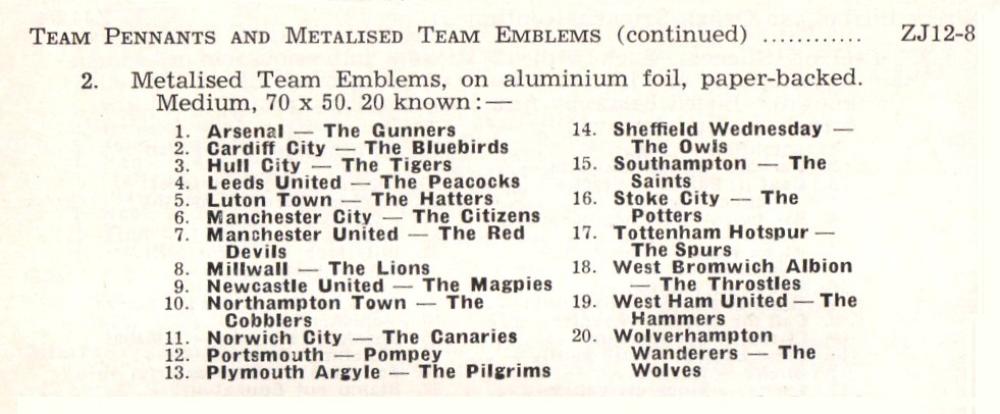
We know that the packets for this set cost 3d. and the emblems are advertised on the front thereof. However it does not say how many cards you got.
Sunday, 28th August 2022
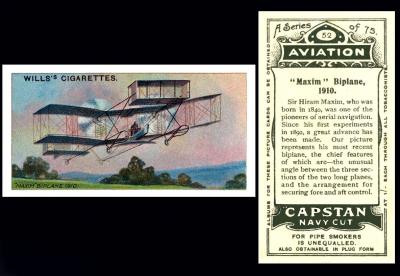
The issue date of this 75 card version does not seem to appear anywhere, so does anyone out there have any ideas? Secondly this set is stated to be cards 1-50 of the standard version plus 25 extra cards.As far as a list I had a breakthrough, as there is a list online, with card pictures - check the av8r blog / Wills Aviation.
The connection with Blackpool concerns a ride in the pleasure gardens called Sir Hiram Maxim`s Captive Flying Machine - which is thought to be the oldest in Europe. It was immensely successful, but he was never satisfied with it.
If you look at postcards of the 1904 Earls Court Exhibition you will spot one there, either in the distance or fully featured; one of the best of them is a really close up view captioned "Fly by Night".
The survival of the one at Blackpool proves this entirely wrong.
Monday, 29th August 2022
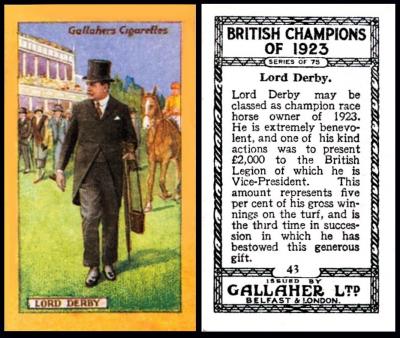
The clue here was that Lord Derby was the first to physically light the illuminations at Blackpool, in 1934. What I don`t know is why he was chosen. Do any of you?
WelI, confession time, I intended to make the rest of the week all his fellow lighters uppers, but have drawn a blank on getting cards.
The famous racehorse Red Rum was one, when, in 1977, he walked over the switch. He does appear on a set of "Grand National Winners 1976-1995", twenty large cards by G.D.S. Cards issued in 1997, but it is not a set I have, or know anyone with. And he also appears, as an artists impression, on the back of a set of playing cards advertising Old Holborn Tobacco.
Another exciting illuminatrix was a Canberra bomber, though it actually just flashed its lights as it flew over and the illuminations were started up by someone on the ground. The exciting thing about this was that it was "assisted by Douglas Bader" in some way I have not discovered - yet. Unless he was the switch flicker on the ground ?
At this time, 1909-1929, Gallaher was cornering the market in long sets, most usually of a hundred cards, even the Great War VC Heroes, though split into smaller sections of twenty five, makes up two sets of a hundred. Our set is one of the oddities, for it is only seventy five cards, and it has a very unusual solid orangey yellow border. But in the very same month another set, of twenty five cards, with the same border, was issued. That was called "Champion Animals and Birds". So was the intention to call these two parts of a hundred card set called "Champions"?
The evidence is compelling, for both were printed by Norbury, Natzio & Co. Ltd of Manchester, the only Gallaher sets they printed. And our original Gallaher reference book (RB.4), issued in 1944, adds more - for it says that "cards are known with wrong descriptions", namely descriptions from "Champion Animals and Birds" on the backs of cards from "British Champions of 1923", and descriptions from "British Champions of 1923" on the backs of cards from "Champion Animals and Birds". And the only way this could happen is if the cards were produced at the same time.
Tuesday, 30th August 2022
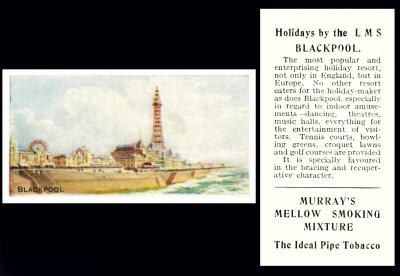
This is another railway related set that a lot of railway collectors do not know about, for the L.M.S. was the London, Midland and Scottish Railway, which at one time was the largest of the main rail providers in the United Kingdom, and was operational between 1923 and 1948.
The closest LMS station to the tramway was Stoney Hill, and that was opened in 1865. It only lasted until 1872 though. Then on the 14th of September 1931, Squires Gate was opened, and, in the late 1930s, that also seems to have operated camping facilities in decommissioned railway carriages. These lasted until the outbreak of the Second World War, but they also returned in the late 1950s and went on until they were not required in the 1970s, possibly due to the growth in overseas and package holidays.
Now this card was actually issued by Murray, Sons and Company Ltd., of Belfast, in Northern Ireland. They started in 1810, but took quite a while to decide to become a Limited Company. This may have been caused by the fact that they kind of teamed up with Gallaher Limited, who had moved to Belfast from Liverpool in 1867. Murrays specialised in pipe tobacco, mainly because they never seemed to get on with making cigarettes to the quality that other companies did. However their pipe tobacco was constantly praised, and won awards.
This card is branded for Mild and Mellow Honeydew, which was a straight Virginia, in other words not a blend of any other tobacco. Some of their other brands, especially the oldest ones, were, and these were called American Tobacco, like their two earliest dated brands, the "Murrays 1810 Belfast" and the "Murrays 1862 Whitehall". When the tobacco was simply a dual blend, one other with Virginia, it was either Perique - which is a very rare type of tobacco from Louisiana, known by the original Native Americans - or Latakia - which came from Syria at that time but due to political and military unrest now comes from Cyprus. You will actually see Latakia mentioned on the back of the Grapnel Mixture of Taddy & Co “Prominent Footballers” (1908-9 issue).
In 1953 Murrays was bought out by Carreras, but their ownership was brief, and they merged with Rothmans in 1958. For a short while the two names were used together, as Carreras Rothmans Limited, but then, in the early 1970s, the proof came that the merger had not been so friendly, and Carreras disappeared in favour of simply Rothmans International. And Rothmans International is now part of British American Tobacco.
These cards are very slightly wider than standard at 36 x 70 m/m
Now Ha.593 is a handbook reference and it is scanned here, for it lists all the cards in the set these, for some reason, being un-numbered -

Wednesday, 31st August 2022
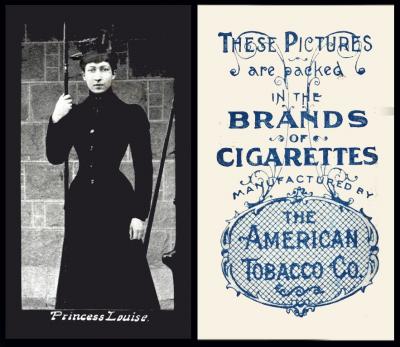
The first lights at Blackpool took place in September 1879 but it was not as we know it today with strings of coloured bulbs - it could not have been, for the light bulb had yet to be patented. Instead it was simply eight large lamps, similar to searchlights, on the promenade.
The first actual light bulbs were hung up in May 1912, also on the Promenade, and they were set in motion by Princess Louise, who is showing here, the first member of the Royal Family to visit the resort, and after whom Princess Parade is named.
Now we asked you who was her husband, and what was his link to cartophily - and the answer is that he was The Marquis of Lorne, the one featured on one of the earliest cigarette cards yet discovered.
The event, and the lights, made the headlines, so much so that even before the glow had diminished it was decided that the lights would return in 1913. Again this was a great success and the extra moneys being spent by the visitors was also popular with the local business and hotels. However in 1914 the First World War saw the illuminations off the calendar, and they would not return for some considerable time.
This set was issued in America, over a few years, and reprinted several times, so there are differences in the lettering style, the size, and the colour and quality of the board, plus the shade of blue used for the reverse image. There are also varieties included, and these are a good way to date the cards for two of the titles were changed after the 22nd of January 1901 owing to the death of Queen Victoria and the succession of her son to the throne - "HRH The Prince of Wales" card becoming "His Majesty Edward VII" and "Princess of Wales" card becoming "Her Majesty Queen Alexandra". The third card affected is "The Right Sir G.H. Reid, P.C. Q.C.", who becomes "The Right Hon G.H. Reid, P.C. Q.C." - he seems to have been an Australian politician, so if anyone would like to add his details please email them in.
Jefferson Burdick calls the set "Celebrities" but says it is "mostly Royalty"., in a rather unexcited manner, perhaps why he valued the cards at just 20 cents each. By the way it is to him that we owe the final TW94 code, which is derived from our RB.18/94, reference book 18 being the Tobacco War booklet.
Thursday, 1st September 2022
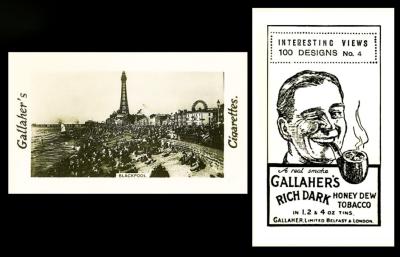
This set, which does remind me very much of those little pictures you get in the sticks of rock, marks an important date in Blackpool`s story, though when it was issued in 1923 the illuminations were still a distant pre First World War memory.
The first thing I noticed was the number of people crowded on to the beach. And so I looked it up. What I discovered was that is good reason for this, because 1923 was the year of the first ever Blackpool Carnival. It is quoted that over eight days it was possible to find every manner of entertainment, dog shows, dancing, parades, and floats; and that over two million people were there, many of whom could not even find accommodation and had to sleep on the beach. Perhaps some of these are some of those ?
If you look at the back of this card it is a very odd one, no text, and this huge advertisement for Gallaher`s Rich Dark Honey Dew Tobacco, in 1, 2 and 4 oz tins. This was a very popular brand, and it was often advertised with a beautiful and mysterious brunette smouldering against a deep browny black background. I have not been able to find this advertisement yet, but the colour and the way it is drawn suggests it was perhaps a newspaper advert. Can anyone confirm this?
Here is the listing for our set from our original Gallaher reference book, issued in 1944 :
1923. 100 INTERESTING VIEWS (titled series). Size 2 1/2" x 1 1/2". Numbered 1-100. REAL PHOTOGRAPHS. Fronts, toned black and white, glossy finish. "Gallaher`s Cigarettes" in wide margins, subjects titled. Backs, printed in black, "100 Designs", no descriptions, inscribed "A real smoke Gallaher`s Rich Dark Honey Dew Tobacco, " etc. Produced by Phillip G. Hunt & Co., London.
Now Philip G Hunt & Co. are quite well known, as they also printed picture postcards. They moved about a bit, though; in 1912 they were at Paternoster Row in the heart of London, then in the 1920s cards can be found citing Balham High Road in South West London.
And I will stop here because there is something very interesting about this set which will be revealed tomorrow....
Friday, 2nd September 2022
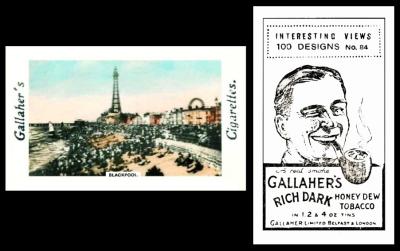
Now yesterday we promised you a bit of a surprise with our next card, and here it is!
But first, this set was issued in 1925, which was the year that saw the return of the illuminations. They were also much larger, running along the Promenade for several miles.
However there was still no celebrity switching them on - not until 1934.
If you look at the pair in the newsletter it is actually easier, as you can just flick the page up and down, and when you do you will see that today`s card is identical to yesterday`s except for the fact that it has been coloured.
Now before you think that this was done by hand, here is the listing for both sets from our original Gallaher reference book, issued in 1944 :
1923. 100 INTERESTING VIEWS (titled series). Size 2 1/2" x 1 1/2". Numbered 1-100. REAL PHOTOGRAPHS. Fronts, toned black and white, glossy finish. "Gallaher`s Cigarettes" in wide margins, subjects titled. Backs, printed in black, "100 Designs", no descriptions, inscribed "A real smoke Gallaher`s Rich Dark Honey Dew Tobacco, " etc. Produced by Phillip G. Hunt & Co., London.
1925. 100 INTERESTING VIEWS (titled series). Size 2 1/2" x 1 1/2". Numbered 1-100. REAL PHOTOGRAPHS. Fronts, toned black and white, dull finish, and hand-coloured (by stencils) in various colours. Subjects titled. Backs, printed in black, "100 Designs", no descriptions, inscribed "A real smoke Gallaher`s Rich Dark Honey Dew Tobacco, " etc. Produced by Associated Photographic Printers, London.
I cannot find Associated Photographic Printers, but this card is also number 84 and some people firmly believe that the remainders were sent off to them to be hand coloured, in an attempt to make them more modern. However this cannot be correct because if you look at the description above you will see that the black and white cards were glossy, and the hand-coloured cards were specially produced in a matt format. You see, to this day, colourists and painters of photographs prefer a matt surface. which not only avoids the glare when you look at the image in the light, but also means that the colour does not slide about before it has dried.
In our original World Tobacco Issues Index this fact is also mentioned, for the set is listed as :
INTERESTING VIEWS. Sm. Photos. Nd. (100).
A. Uncoloured, glossy
B. Hand-coloured, matt.
This wording is slightly different in our updated version though, as it replaces "uncoloured" with B & W
Sad to say we have reached the end for another week. Hope you enjoyed it?
This weekend I am going to try and complete the index of cards and subjects as featured in these newsletters. That will allow me to bring you more new cards, and allow you to supply scans of any important missing cards, back and front, from your collections. It will also allow me to start working through the magazine library and adding in other information about these cards. So lots to look forward to!
Have a great weekend...
